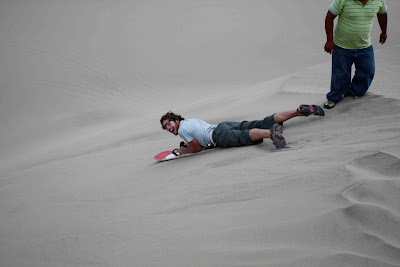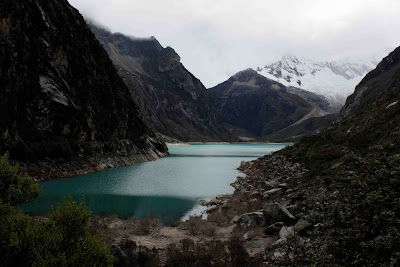I feel like we're really motoring now. Back to similar speeds of travel we achieved through Mexico when we'd be moving every one to two days. We've a little over a month left meaning there is no time to laze around. So, after the delights of Cusco and the striped pants brigade, we took a bus to Puno for a taste of Lake Titicaca on the Peruvian side.
The journey to Puno took longer than the six hours owing to a poorly bus. This was a first. I don't know how many miles we've travelled since the start of last October, but this is the first time we've had any bus trouble. Quite I feat I think, considering we've travelled in some pretty dodgy transport - none more so than the old US state school buses which are everywhere in Central America! But they got the bus working again and we limped on to Puno, albeit some two hours late.
Puno is quite unimpressive. Even with the vast Lake Titicaca in view, the town somehow maintains a drab appearance, mostly owing to the hundreds of terrible half built buildings littering the place. But you can't have everything. At least we were free to walk the streets without be accosted by restauranteurs or massage ladies. It is worth climbing to one of the view points high up. Everything looks much better from up there.
From Puno you can take boat trips to any of the three closest islands on Lake Tititcaca. It's the reason most people would venture to Puno. We had planned on a full day trip that would take us to two of the islands: The Uros floating islands and Taquile. However, owing to a terrible night's sleep - which I blame on the altitude (we're at 3,855m, which is higher than La Paz in Bolivia) - we only went for an afternoon trip to The Uros.
Our guide book didn't sound too thrilled about the Uros islands. The people there have constructed their islands from reeds. They use reeds for everything; their houses, their boats and as carpets. They live off the lake by fishing and hunting birds. But, so the book described, these days they have a secondary source of income: tourism. The book went on to say that the islands that you visit by boat are little more than "floating souvenir stalls". Cue the tourist trap alarm bells ringing in my head! But at the very least I was curious. It should be worth seeing the floating islands as you don't see them everyday.
We joined eight or so others and after about half an hour on the boat from the Puno dock, the islands started to come into view. I was reminded of that dreadful Kevin Costner film Waterworld, you know, the 90's big budget flop? This community had created land for themselves way out in the quite serene settings of the lake. There was a central canal and to either side were groups of islands. We stopped at one, got out and were confronted by, you guessed it, souvenir stalls. Luckily the awkward situation was broken by a guy who gathered us around a big map of the lake and started to explain about the islands and the people on them. He described how the islands are made, using the roots of the reeds and ropes and anchors and lastly, lots of cut reeds on top to make a soft floor. I was very glad of this. Not only was it interesting but it meant that it wasn't just us, the souvenir stalls and a bunch of people staring at us waiting for us to part with our Soles. Spend your money foreigners, they would be thinking, What's the matter? Are you too stingy??
Afterwards we were persuaded to take a reed boat to the next island. The onboard entertainment was three young Urovians(?) who gave us a three song performance, in exchange for a donation. The first song in Spanish, the second in Quechua and the third in English. In English we were treated to Twinkle Twinkle Little Star, which when sung, they substituted the word twinkle for the word Gringo. Adorable!
This ten minute reed boat journey set us back five Soles each, which is extortionate given that you could go two hours on a bus for that. The next island was much like the same as the last but it had a restaurant. The Latin American family with us (who were generally lapping up the whole experience) went and had a big meal and as it was about four o'clock and we weren't at all hungry, we just sat and waited until they'd finished. It wasn't as if you could go exploring. The island was small. You'd need to hijack the reed boat.
The Uros experience was everything I had feared it would be. It was really cool to see the islands, plus I do love a boat ride, but the forced tourist trap thing will always make me feel uncomfortable.
Country Notes and Tales From Travellers
13 years ago





















































